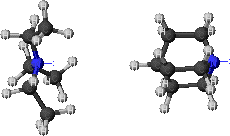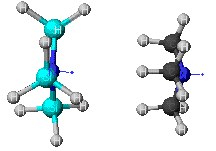Lewis Acid-Base Experiment
Introduction
Lewis acids, which are electron pair acceptors, and Lewis bases, which are electron pair donors, react to form adducts in which a coordinate covalent bond is formed. This type of bond is usually represented by an arrow. The strength of the interaction between a Lewis acid and a Lewis base is controlled by at least two factors, electronic and steric (1). Electron donating groups on an atom can increase the Lewis basicity of that atom, while electron-withdrawing groups can increase the Lewis acidity. Trivalent nitrogen and boron compounds are common examples of Lewis bases and acids, respectively. Trimethylamine, N(CH3)3, is a Lewis base and because of the electron donating methyl groups, it should be a stronger base than NH3 when both are compared with a common Lewis acid. Similarly, one would expect BF3 to be a stronger Lewis acid than B(CH3)3.
Steric factors affect both Lewis acids and bases in similar ways. A trivalent boron compound is triangular planar with an sp2 hybridized boron atom. When a Lewis acid-base adduct is formed, the boron atom is rehybridized to sp3 and the three groups on boron are forced closer together. Large, bulky groups on boron will not favor being forced closer together and this will affect the strength of the interaction. As well, a trivalent nitrogen compound is pyramidal and the nitrogen is sp3. No rehybridization of the nitrogen occurs upon adduct formation, but large, bulky groups on nitrogen will prefer a more planar geometry to minimize non-bonded repulsions. When the Lewis acid-base adduct is formed, the groups on nitrogen are also forced closer together which again, affects the strength of the interaction. Finally, large, bulky groups on both boron and nitrogen can prevent the close approach of the bonding atoms. This is sometimes referred to as F-strain.
One measure of the strength of a Lewis acid-base interaction is the heat of reaction, DHrxn. Heats of reaction can be estimated from the heats of formation, DHf, of the reactants and product. Recall that, DHrxn = S[DHf(products)] - S[DHf (reactants)]. The more negative the DHrxn, the stronger the Lewis acid-base interaction. The heats of formation are calculated from a semi-empirical calculation. In this experiment, the modeling program CAChe was used and the MOPAC application was used to obtain thermodynamic values. The resulting heats of reaction may not agree well with experimental results in all cases, but the trends in DHrxn observed for a single series of reactions are consistent with expected results of acid-base strength.
Modeling and Calculation Exercises
In each of the studies (1-5) below it is necessary to build the reactants and products in the CAChe Editor, mimimize the geometry of each with Molecular Mechanics and then minimze geometry again with MOPAC ( AM1). The MOPAC-results will produce the heat of formation for each molecule. Also, from the MOPAC-minimized-geometry atom distances and bond angles can be obtained using the Adjust menu in Editor. The acid-base bond must be a Coordinate bond from base to acid.
- Boron Trihalides + Ammonia
Consider the reactions of BX3 (X = F, Cl, Br) with NH3. Calculate the heats of reaction and rank the boron halides in acid strength. Also, it may be informative to obtain the B-N bond distance for each adduct as well as the values of some bond angles which may undergo a change upon reaction. Discuss your results in terms of the electronic properties of the boron halides (2,3). It will be necessary to consider p-bonding effects in the boron halides. The results obtained for this series of reactions are shown in Table I below.

(In Table I below and all others that follow, LA = Lewis acid, LB = Lewis base and all values are in kcal/mol):
Table I LA DHf(LA) LB DHf(LB) DHf(adduct) DHrxn
BF3 -272.15 NH3 -7.28 -291.81 -12.38 BCl3 -97.01 NH3 -7.28 -140.14 -35.85 BBr3 -50.05 NH3 -7.28 -91.39 -34.06
- Trialkylboron Compounds + Ammonia
Consider the reactions of BR3 [R = CH3 (Me), C2H5 (Et), C3H7 (n-Pr and i-Pr)] with ammonia. Calculate the heats of reactions as before from the heats of formation. Discuss your results in terms of both the changing electronic and steric effects on the boron atom. The four trialkylboron Lewis acids are shown below and the results obtained for this series of reactions are contained in Table II.
Table II LA DHf(LA) LB DHf(LB) DHf(adduct) DHrxn
BMe3 -24.60 NH3 -7.28 -54.48 -22.60 BEt3 -38.13 NH3 -7.28 -70.74 -25.33 B(n-Pr)3 -58.27 NH3 -7.28 -90.05 -24.50 B(i-Pr)3 -45.07 NH3 -7.28 -70.60 -18.25
- Trialkylboron Compounds + Trialkylamines
In this series of reactions the Lewis base remains the same at trimethylboron while the alkyl groups on nitrogen increase in size. Again, obtain the heats of formation and calculate the heats of reaction. Interpret the trend in heats of reaction in terms of the changing electronic and steric effects on the nitrogen atom. The four trialkyamines are shown below and the results obtained for this series of reactions are contained in Table III.
Table III LA DHf(LA) LB DHf(LB) DHf(adduct) DHrxn
BMe3 -24.60 NMe3 -1.71 -26.01 0.30 BMe3 -24.60 NEt3 -14.93 -38.09 1.44 BMe3 -24.60 N(n-Pr)3 -35.89 -58.04 2.45 BMe3 -24.60 N(i-Pr)3 -19.40 -14.96 29.40
- Pyridine and Substituted Pyridines + Trimethylboron
In this study pyridine (Py), 4-methylpyridine (4-MePy), 2-methylpyridine (2-MePy) and 2,6-dimethylpyridine (2,6-diMePy) will be allowed to react with trimethylboron. This series of pyridines represents an interesting "control" of steric and electronic factors. Interpret the heats of reaction results in terms of both the changing electronic and steric factors of the four pyridines which are shown below (4). The thermodynamic results are contained in Table IV.
Table IV
LA DHf(LA) LB DHf(LB) DHf(adduct) DHrxn
BMe3 -24.60 Py 32.05 3.43 -4.02 BMe3 -24.60 4-MePy 24.17 -4.73 -4.30 BMe3 -24.60 2-MePy 25.72 2.33 1.21 BMe3 -24.60 2,6-DiMePy 19.51 2.32 7.41
- Other Interesting Studies
- Basicity of Triethylamine vs. Quinuclidine.- Consider reactions of both triethylamine [NEt3] and quinuclidine [N(CH2CH2)3CH] with trimethylboron (4). The two bases, which are shown below, should have similar electronic effects, but they should have different steric constraints. The nitrogen lone pair on quinuclidine should be more accessible to a Lewis acid than that of triethylamine. The thermodynamic results are shown in Table V.
- Basicity of Trimethylamine vs. Trisilylamine.- Compare the reactions of trimethylboron (BMe3) with both trimethylamine (NMe3) and trisilylamine (N(SiH3)3). The MOPAC-minimized-geometry of N(SiH3)3 shows the compound to be planar with an sp2 nitrogen, while the geometry of N(CH3)3 is pyramidal with an sp3 nitrogen. The planar geometry in N(SiH 3)3 is presumably due to pp- dp bonding between a nitrogen 2p orbital and empty 3d orbitals on Si (5). This p-bonding decreases the Lewis basicity of N(SiH3)3 by delocalizing the nitrogen lone pair. The steric effects between N(SiH3)3 and NMe3 should be very similar, and any differences in the heats of reacton can be attributed to electronic effects. The thermodynamic results are collected in Table V.
Table V LA DHf(LA) LB DHf(LB) DHf(adduct) DHrxn
BMe3 -24.60 NEt3 -14.93 -38.09 1.44 BMe3 -24.60 N(CH2CH 2)3CH -8.18 -34.49 -1.71 BMe3 -24.60 NMe3 -1.71 -25.98 0.32 BMe3 -24.60 N(SiH3)3 -30.57 -32.58 22.58
References
- Muetterties, E. L. The Chemistry of Boron and Its Compounds; John Wiley & Sons, Inc.: New York, 1967; pp. 9, 232.
- Greenwood, N. N.; Earnshaw, A. Chemistry of the Elements; Pergamon Press: New York, 1984; p. 220.
- Brown, H. C.; Holmes, R. R. J. Am. Chem. Soc. 1956, 78, 2173.
- Cotton, F. A.; Wilkinson, G.; Gaus, P. L. Basic Inorganic Chemistry; 3rd ed.; John Wiley & Sons, Inc.: New York, 1995; p 228.
- Livant, P.; McKee, M. L.; Worley, S. D. Inorg. Chem. 1983, 22, 895-901.





0 comments:
Post a Comment